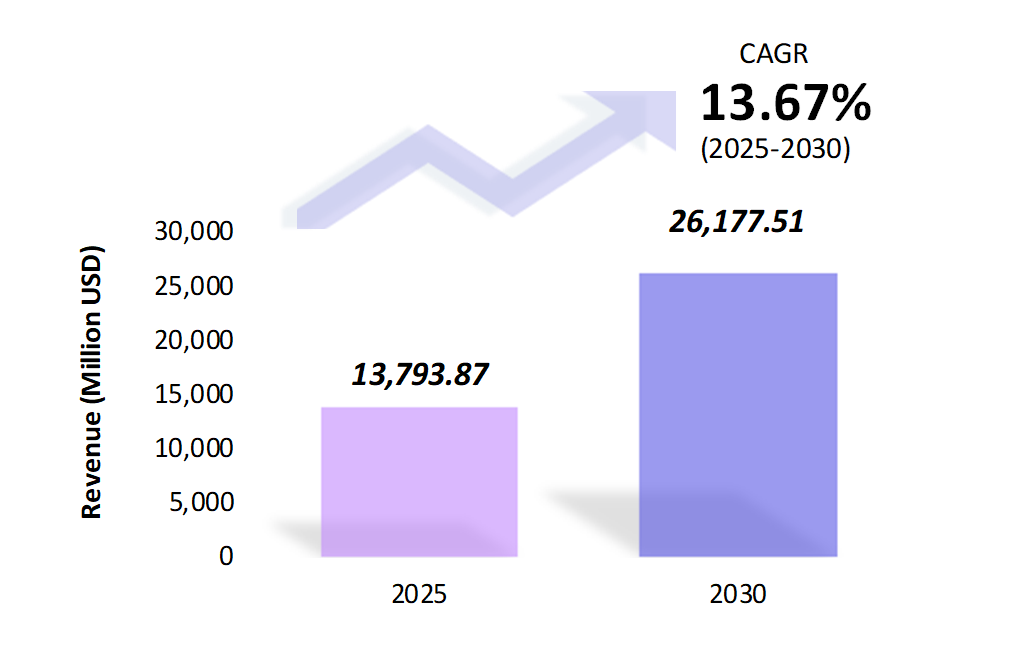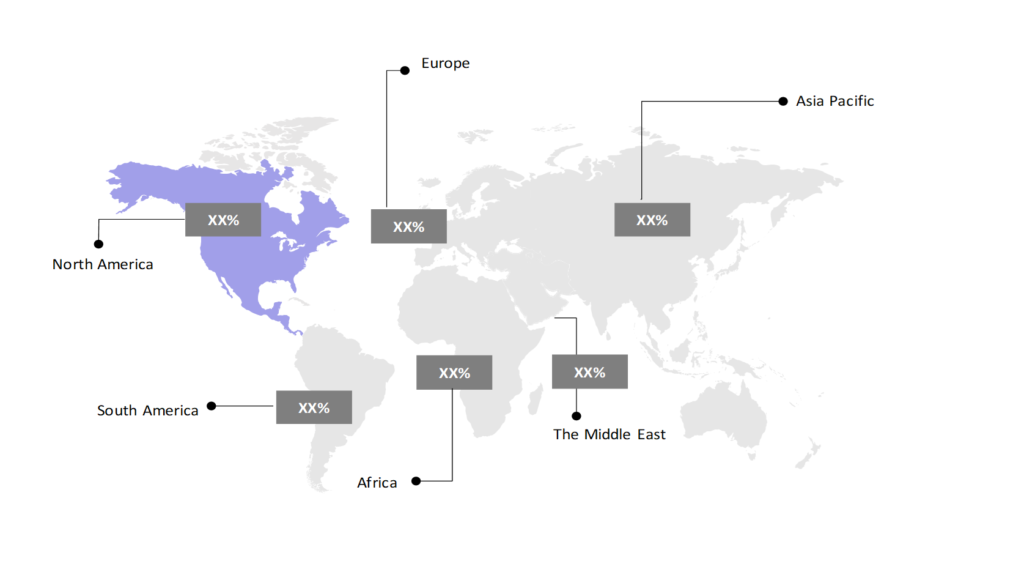Hydrogen Pipeline Market Outlook: Size, Share, Trends & Growth Analysis (2024-2029)
The market report presents a thorough analysis segmented by Type (Mobile Pipelines, Fixed Pipelines); by Pipeline Structure (Metal, Plastics & Composites); by Geography (North America, South America, Asia Pacific, Europe, The Middle East, Africa).
Outlook

- The hydrogen pipeline market is estimated to be at USD 13,793.87 Mn in 2025 and is anticipated to reach USD 26,177.51 Mn in 2030.
- The hydrogen pipeline market is registering a CAGR of 13.67% during the forecast period 2025-2030.
- The global hydrogen pipeline market is gaining significant momentum due to the growing adoption of hydrogen as a clean energy source. With the increased focus on reducing carbon emissions and advancing hydrogen-based energy solutions, the need for dedicated pipelines for hydrogen transportation is becoming crucial.
Request a free sample.
Ecosystem

- The global hydrogen pipeline industry participants are continuously developing their strategies to preserve a competitive advantage.
- These companies focus on hydrogen production, storage, innovative solutions, acquisitions, partnerships, and technological launches.
- Several important entities in the hydrogen pipeline
Ask for customization.
Findings
| Attributes | Values |
|---|---|
| Historical Period | 2019-2023 |
| Base Year | 2024 |
| Forecast Period | 2025-2030 |
| Market Size (2025 | USD 13,793.87 Mn |
| Market Size (2030 | USD 26,177.51 Mn |
| Growth Rate | 13.67% CAGR from 2025 to 2030 |
| Key Segments | Type (Mobile Pipelines, Fixed Pipelines); Pipeline Structure (Metal, Plastics & Composites); Geography (North America, South America, Asia Pacific, Europe, The Middle East, Africa) |
| Key Vendors | Cenergy Holdings S.A.; SoluForce B.V.; Salzgitter AG; Gruppo Sarplast S.r.l; Tenaris S.A. |
| Key Countries | The US; Canada; Mexico; Brazil; Argentina; Chile; China; India; Japan; The UK; Germany; France; UAE; Saudi Arabia; Egypt; Morocco |
| Largest Market | North America |
Get a free quote.
Trends
- Hydrogen Pipeline Innovations in Offshore Wind Farms: There is a growing emphasis on integrating hydrogen pipelines with offshore wind farms, facilitating the direct transport of green hydrogen from wind energy to onshore facilities. This innovative approach enhances the efficiency of renewable energy use and streamlines the hydrogen supply chain, paving the way for more sustainable energy systems.
- Use of Digital Monitoring Technologies: Digital monitoring technologies, such as sensors and a
Artificial iIntelligence (AI)-driven systems, are becoming increasingly important to ensure the integrity and safety of hydrogen pipelines. These technologies are crucial in detecting leaks and preventing failures in real time. In 2022, Honeywell and Emerson began implementing AI-driven sensors in hydrogen pipelines to improve real-time monitoring and leak detection.
- Increasing Focus on Hydrogen Blending in Natural Gas Networks: There is a growing trend of blending hydrogen into existing natural gas pipelines to leverage existing infrastructure for a quicker transition to hydrogen use. Countries like Germany and the UK are experimenting with hydrogen-natural gas blends in pipelines to reduce carbon emissions without requiring entirely new infrastructure.
Speak to analyst.
Catalysts
- Rising Demand for Hydrogen in Industrial Applications: The rising adoption of hydrogen in sectors such as steel production, chemical manufacturing, and oil refining drives the demand for robust transportation infrastructure. As industries shift towards cleaner energy sources, establishing reliable systems for hydrogen transport becomes crucial to ensure efficient delivery and support the transition to a low-carbon economy.
- Energy Transition Policies and Carbon Neutrality Goals: Governments worldwide are implementing policies to achieve carbon neutrality by 2050. These policies are driving the adoption of hydrogen as a key energy source. In 2022, the Biden administration in the U.S. unveiled a hydrogen roadmap to support the development of a national hydrogen pipeline network.
- Decarbonization of the Transportation Sector: The transportation sector is increasingly turning to hydrogen-based fuel cells to decarbonize heavy-duty vehicles and shipping, significantly driving the demand for pipelines to transport hydrogen. This shift not only aids in reducing greenhouse gas emissions but also promotes the establishment of a comprehensive hydrogen infrastructure that can support the transition to cleaner transport solutions.
Inquire before buying.
Restraints
- High Initial Investment and Infrastructure Costs: Constructing new hydrogen pipelines demands significant capital investment, which presents a challenge for advancing hydrogen infrastructure. This financial hurdle slows the deployment of essential pipeline networks needed for efficient hydrogen distribution, hindering the broader adoption of hydrogen as a clean energy source.
- Hydrogen Embrittlement and Safety Concerns: Hydrogen embrittlement, a phenomenon where hydrogen atoms infiltrate and weaken pipeline materials over time, poses a severe safety concern in hydrogen transport. This degradation increases the risks of leaks or catastrophic failures, necessitating rigorous material testing and selection to ensure pipeline integrity.
- Regulatory and Standardization Barriers: Varying regulations and the lack of standardized policies for hydrogen transportation across regions create market entry challenges. In 2023, countries like the U.S. and the EU introduced frameworks to address regulatory inconsistencies, but global standardization remains an ongoing challenge.
Personalize this research.
Hotspot

Explore purchase options.
Table of Contents
| 1. Introduction 1.1. Research Methodology 1.2. Scope of the Study 2. Market Overview / Executive Summary 2.1. Global Hydrogen Pipeline Market (2019 – 2023) 2.2. Global Hydrogen Pipeline Market (2024 – 2030) 3. Market Segmentation 3.1. Global Hydrogen Pipeline Market by Type 3.1.1. Mobile Pipelines 3.1.2. Fixed Pipelines 3.2. Global Hydrogen Pipeline Market by Pipeline Structure 3.2.1. Metal 3.2.2. Plastics & Composites 4. Regional Segmentation 4.1. North America 4.1.1. The US 4.1.2. Canada 4.1.3. Mexico 4.2. South America 4.2.1. Brazil 4.2.2. Argentina 4.2.3. Chile 4.2.4. Rest of South America 4.3. Asia Pacific 4.3.1. China 4.3.2. India 4.3.3. Japan 4.3.4. Rest of Asia Pacific 4.4. Europe 4.4.1. The UK 4.4.2. Germany 4.4.3. France 4.4.4. Rest of Europe 4.5. The Middle East 4.5.1. UAE 4.5.2. Saudi Arabia 4.5.3. Rest of the Middle East 4.6. Africa 4.6.1. Morocco 4.6.2. Egypt 4.6.3. Rest of Africa 5. Value Chain Analysis of the Global Hydrogen Pipeline Market 6. Porter Five Forces Analysis 6.1. Threats of New Entrants 6.2. Threats of Substitutes 6.3. Bargaining Power of Buyers 6.4. Bargaining Power of Suppliers 6.5. Competition in the Industry 7. Trends, Drivers and Challenges Analysis 7.1. Market Trends 7.1.1. Market Trend 1 7.1.2. Market Trend 2 7.1.3. Market Trend 3 7.2. Market Drivers 7.2.1. Market Driver 1 7.2.2. Market Driver 2 7.2.3. Market Driver 3 7.3. Market Challenges 7.3.1. Market Challenge 1 7.3.2. Market Challenge 2 7.3.3. Market Challenge 3 8. Opportunities Analysis 8.1. Market Opportunity 1 8.2. Market Opportunity 2 8.3. Market Opportunity 3 9. Competitive Landscape 9.1. Cenergy Holdings S.A. 9.2. SoluForce B.V. 9.3. Salzgitter AG 9.4. Gruppo Sarplast S.r.l 9.5. Tenaris S.A. 9.6. Company 6 9.7. Company 7 9.8. Company 8 9.9. Company 9 9.10. Company 10 |
Know the research methodology.
Hydrogen Pipeline Market – FAQs
1. What is the current size of the hydrogen pipeline market?
Ans. In 2025, the hydrogen pipeline market size is USD 13,793.87 Mn.
2. Who are the major vendors in the hydrogen pipeline market?
Ans. The major vendors in the hydrogen pipeline market are Cenergy Holdings S.A.; SoluForce B.V.; Salzgitter AG; Gruppo Sarplast S.r.l; Tenaris S.A.
3. Which segments are covered under the hydrogen pipeline market segments analysis?
Ans. The hydrogen pipeline market report offers in-depth insights into Type, Pipeline Structure, and Geography.
